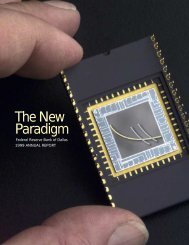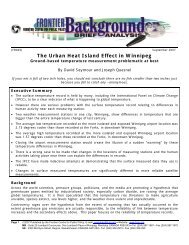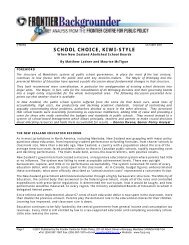The New Paradigm - Federal Reserve Bank of Dallas
You also want an ePaper? Increase the reach of your titles
YUMPU automatically turns print PDFs into web optimized ePapers that Google loves.
6<br />
Roughly 1.3 million Americans work in the cell phone industry—making<br />
the phones and their components, handling services and sales, and<br />
doing other jobs. Without the chip, this industry and many others<br />
wouldn’t exist.<br />
<strong>The</strong> most far-reaching implication <strong>of</strong> the <strong>New</strong> Economy<br />
centers on the trade-<strong>of</strong>f between growth and inflation.<br />
Now, unemployment can go lower and growth higher without<br />
igniting inflation. Policymakers working under yesterday’s<br />
mind-set had to be vigilant about growth and job creation,<br />
reacting quickly to slow the economy before prices<br />
spiraled out <strong>of</strong> control.<br />
<strong>The</strong> <strong>New</strong> Economy is a controversial concept, still being<br />
shaped by debates over its import and implications. That’s<br />
not surprising, because adjusting to changes in economic<br />
fundamentals takes time. <strong>The</strong> United States has passed<br />
through several economic eras. We began as an agricultural<br />
society. After the mid-19th century, the steam engine<br />
and then electricity transformed the country into an industrial<br />
nation. Today, deep into the Information Age, old economic<br />
theories fail to explain new realities and policy signposts<br />
don’t mean what they once did.<br />
<strong>The</strong> challenge lies in adjusting our thinking to the new<br />
realities.<br />
<strong>The</strong> Microprocessor Miracle<br />
Until the 1990s, contemporary Americans considered<br />
the 1960s the quintessential good times because the<br />
United States enjoyed uninterrupted growth for almost<br />
nine years. 2 <strong>The</strong> 1960s, however, don’t provide the best<br />
corollary for what’s happening in today’s economy. We<br />
need to travel further back in time.<br />
From 1895 to 1915, a great burst <strong>of</strong> inventiveness ushered<br />
in an era <strong>of</strong> rapid technological change and economic<br />
growth. Americans saw the arrival <strong>of</strong> one marvel after<br />
another—automobiles, airplanes, telephones, phonographs,<br />
radios, elevators, refrigeration and much more.<br />
<strong>The</strong>se new inventions barely registered as a blip in a GDP<br />
dominated by farming, shopkeeping and small-scale production.<br />
In time, though, the industries that grew out <strong>of</strong><br />
them formed the economic backbone <strong>of</strong> the 20th century.<br />
<strong>The</strong> advances <strong>of</strong> this long-ago era would have been<br />
impossible without a technology that arrived just after the<br />
Civil War: electricity. Thomas Edison, the greatest <strong>of</strong> American<br />
inventors, created the lightbulb in 1879 for the simple<br />
task <strong>of</strong> illuminating a room. To build a market for his<br />
invention, Edison harnessed electricity, building the<br />
world’s first generating plant and distribution network in<br />
<strong>New</strong> York City. As it spread through the economy, electricity<br />
recast the economic paradigm.<br />
Edison, without intending anything more than turning<br />
night into day, triggered a revolution. Without electricity,<br />
there would be no spark for internal combustion engines,<br />
no power for telephones, radios, refrigerators and air conditioners.<br />
Electricity provided an ever-ready energy source<br />
for factories, with mass production driving down the cost <strong>of</strong><br />
making just about everything. Without it, we’d still rely on<br />
muscles, steam and wind, rather than electric motors and<br />
gasoline engines. We’d still be living in a world <strong>of</strong> horsedrawn<br />
carriages, candles, ice houses and cottage industries.<br />
Like electricity, the microprocessor is an important<br />
invention in its own right and one that shook the world as<br />
it touched <strong>of</strong>f a rapid-fire proliferation <strong>of</strong> spillovers. <strong>The</strong><br />
device traces its origins to <strong>Dallas</strong>, where in 1958 Jack Kilby<br />
<strong>of</strong> Texas Instruments fashioned the first integrated circuit,<br />
a bundle <strong>of</strong> transistors on a piece <strong>of</strong> silicon. Thus began the<br />
grand theme <strong>of</strong> modern electronics—ever smaller, ever<br />
more powerful. Thirteen years later, Ted H<strong>of</strong>f <strong>of</strong> Intel<br />
1999 ANNUAL REPORT <strong>Federal</strong> <strong>Reserve</strong> <strong>Bank</strong> <strong>of</strong> <strong>Dallas</strong>

















